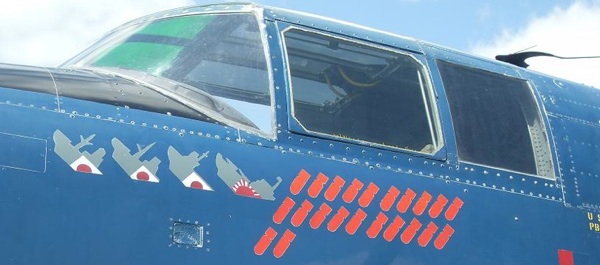B-25s Gather to Honor Doolittle Raid Anniversary

On April 18, 2010, seventeen flyable B-25 World War II bombers participated in an event at the National Air Force Museum in Dayton, Ohio, commemorating the 68th anniversary of the Doolittle Raid on Japan.
It was reportedly the largest gathering of B-25s since 1970, tying the number used during the filming of Catch-22. During filming on that movie, the WWII workhorses flew a total of 1,500 hours and appear on film for about 10 minutes. The largest previous gathering of privately owned B-25s attracted 16 airframes in 2002 at the 60th anniversary celebration in Columbia, South Carolina.
{default}The daring Doolittle Raid struck several cities in Japan during April 1942 using 16 B-25 medium bombers launched from the carrier USS Hornet, the first successful carrier-based launch of planes of that size. Although the raid caused little damage, it provided a significant boost to morale on the US home front and caused the Japanese to withdraw units to defend the Home Islands. The raid made Lt. Col. James "Jimmy" Doolittle and the B-25 Mitchell bomber famous.
Many B-25s were later converted into aerial gun platforms that carried up to eighteen .50-caliber machine guns; some were even equipped with a 75mm gun. They engaged in ground attack and shipping interdiction missions throughout the Pacific Theater. Almost 10,000 of the fast, maneuverable Mitchell bombers were built. Only about 40 are still flying, but almost half of them attended the 68th anniversary event in Dayton.
The celebration attracted thousands, including some of the remaining survivors: Lt. Col. Richard Cole; Maj. Thomas Griffin; Lt. Col. Robert Hite; MSGT. David Thatcher. Hundreds of supporters waited in line to have memorabilia signed by the veterans.
George Yuellig, of Hillsboro, Ohio, attended the event and recalled his days as an B-25 instructor in Enid, Okla., from January to October 1945.
“The B-25 was one of the best-flying airplanes in service,” Yuellig said. “It was like a dream. It normally cruised at about 200 mph and flew almost as fast on one engine as it did on two.”
Night formation practice was the most difficult part of training fellow pilots, he said.
“The lead plane takes off and makes a wide turn—180 degrees—and comes back. By the time you get to the end of the runway the two students are supposed to have joined up with you. They are coming as fast as they can, and they don’t realize that these B-25s don’t have any brakes on them. They’re coming faster then you are flying so they have a tendency to overshoot you. Many a time I had to duck my head.”
Max Hodges of Atlanta, 55, is pilot of Barbie III, the only B-25H model still flying. He discussed the most common complaint of the aircraft—its loud exhaust. Unlike the B-17, which used supercharged engines, the B-25 had “short-stack” Wright R-2600 radial engines located near the cockpit.
“It’s extremely loud,” Hodges said. “The engines are right there at you. The short-stacks pop, crackle and make a lot of noise. The B-17s are more muffled.”
However, Hodges said he still enjoys flying B-25s, which are faster and more maneuverable than B-17s or B-24s.
“It’s like comparing a Volkswagen to a truck.”
Hodges’ father flew B-25s during World War II but never saw action overseas.
“This is a historical event. It’s the first time in a long time this many airplanes have been together in one place.”
History Flight, a 501(c)3 nonprofit organization, operates Barbie III and uses proceeds from it and other war bird flights to fund searches for MIA from World War II.
However, the cost of maintaining and flying a B-25 can be expensive, according to fellow pilot Ray Fowler. He flies Wild Cargo, a B-25J that had an exciting postwar career as a transport for exotic animals. Fowler said it takes about 160 gallons of fuel to fly for one hour at a cost of $5 per gallon. Including other expenses, that totals about $3,000 per hour. Barbie III and other planes could be chartered for a short flight at a cost of $400 per passenger.
Although they didn’t get to fly, the Kaplan family got a tour of the interior of Barbie III because they support the Fighter Factory in Virginia Beach, which maintains the plane. Ron Kaplan said his father was a B-25 instructor based at Maxwell Air Force Base in Montgomery, Alabama. His sons are named Maxwell and Mitchell.
“It’s great to pass it on to another generation,” he said.
Nine-year-old Maxwell said he enjoyed exploring the cockpit and nose-gun blister the best.
“It definitely felt like riding in it in World War II on a real mission. It just feels so alive,” Maxwell said.
For more on Jimmy Doolittle, read Jimmy Doolittle Reminiscences About World War II and Jimmy Doolittle: Commander of the Doolittle Raid During World War II.
About the Author:
Paul Glasser is a newspaper reporter from Frankfort, Kentucky.












